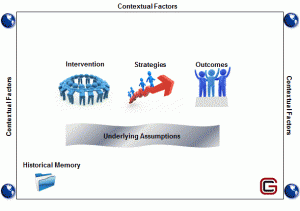
What is a Theory of Change?
A theory of change (TOC) is a tool for developing solutions to complex problems. A basic TOC explains how a group of early and intermediate accomplishments sets the stage for producing long-range results. A more complete TOC articulates the assumptions about the process through which change will occur and specifies the ways in which all of the required early and intermediate outcomes related to achieving the desired long-term change will be brought about and documented as they occur.¹
¹Article in The Evaluation Exchange. Anderson, A., (2005). An introduction of the theory of change. The Evaluation Exchange. 11(2). Retrieved October 17, 2013.
Why a LogicMap?
The LogicMap™ is a unique web-based tool to conduct evaluation and planning while building the theory of change of an intervention. It integrates traditional research methods (site visit observations, surveys, key informant interviews, focus groups, logic modeling, social network analysis) with online resources (websites, images, databases, videos, social media).
Interactive Theory of Change
The LogicMap includes the 6 major elements of the theory of change (TOC). The TOC “clickable” elements are:
1. Intervention: project, program, organization, collaborative or initiative
2. Strategies: approaches or pathways used to achieve outcomes
3. Outcomes: expected or achieved results (short, intermediate, long term)
4. Underlying Assumptions: values and beliefs used to design the intervention and achieve outcomes
5. Contextual Factors: political, economic, social and cultural forces impacting the intervention
6. Historical Memory: evolution of the intervention overtime
Highlights
The LogicMap facilitates quantitative and qualitative data collection, maximizes the ability of programs to demonstrate impact, and simultaneously provide real-time information for present modifications and plan for future programs. It helps engage stakeholders into the planning and evaluation processes. It increases rigor, helps standardize evaluations, and expedites program responses to grant-making requirements in which grants are viewed as investments rather than gifts or contributions. Programs staff and board members, evaluators, planners and policy makers, epidemiologists and other researchers can benefit from this cutting-edge web-based tool.
Properties
|
|
